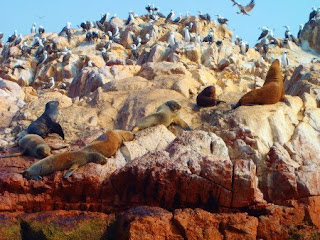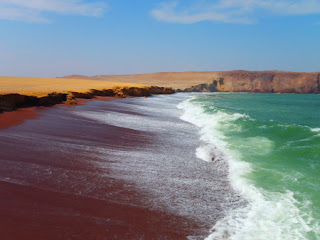 The city is larger than I expected, and the high mountainous roads on which we arrived afforded an impressive view of the city below, with red-tiled roofs and countless church steeples enclosed surrounded by the Ayacucho is isolated deep in the mountains, and wasn’t accessible by paved roads until 1999. It was the site of some of the most intense terrorism in the 1980s by the terrorist organization Sendero Luminoso (Shining Path). During this era of horror and confusion, this group committed atrocities in some of the most remote regions of Peru, contributing to a continued legacy of fear and mistrust. However, Ayacucho appears to be recovering remarkably well from this scarred past, and was recently rated one of the top 10 come-back cities in the world.
The city is larger than I expected, and the high mountainous roads on which we arrived afforded an impressive view of the city below, with red-tiled roofs and countless church steeples enclosed surrounded by the Ayacucho is isolated deep in the mountains, and wasn’t accessible by paved roads until 1999. It was the site of some of the most intense terrorism in the 1980s by the terrorist organization Sendero Luminoso (Shining Path). During this era of horror and confusion, this group committed atrocities in some of the most remote regions of Peru, contributing to a continued legacy of fear and mistrust. However, Ayacucho appears to be recovering remarkably well from this scarred past, and was recently rated one of the top 10 come-back cities in the world.
Ayacucho hosts more than 33 churches within the city boundaries, and each church is unique and nestled in its own corner of the city, often accompanied by a small plaza. We spent Thursday wondering around the city, enjoying the Plaza de Armas as we soaked up the sunshine, blue skies, and incredible weather. Artesania and street food line most corners of Ayacucho, and I quickly found one of my favorite parts of the city; women in traditional dress preparing “queso helado.” These women prepare a sweet, frozen, milky, nutty/cinnamon icecream by swirling their concoction in large metal pots in a bath of ice water. 
Peace Corps volunteers tend to congregate in large groups, which provides certain benefits for transportation and site-seeing. On Friday we decided to rent our own personal combi to do some exploring outside of Ayacucho. The first stop on our self-guided adventure was a famous battlefield, which was marked by a large white monument and surrounded by rolling green hills. 

We continued on to Wari, the site of Pre-Incan ruins located outside of Ayacucho. Although I can appreciate the historic value of ruins, we were pretty tired at this point, so instead of focusing on a guided tour we decided to create our own history lesson for the archaeological site. My favorite part (which is not a fabrication of our own sun-induced silliness) was learning about small bugs that inhabit the cactuses in area. 
On Friday evening the plaza was buzzing with people recognizing the traditions of Good Friday. The events began with artistic demonstrations called “alfombras” or carpets, which were enormous paintings constructed on the street. These paintings were composed entirely of colored saw-dust, spices, flower petals, glitter, and other fine particles formed to create intricate designs on a massive scale. The size and detail was incredible; the artists were able to capture expression and accuracy using tiny particles on a huge canvas. More amazingly, after hours of focused work, these paintings would serve as the “red carpet” of sorts for the Good Friday procession. 

 Each corner balcony was filled with musical groups who serenaded the participants from above. Thousands flooded the center of Ayacucho to participate in this somber candlelit procession in recognition of Christ’s death.
Each corner balcony was filled with musical groups who serenaded the participants from above. Thousands flooded the center of Ayacucho to participate in this somber candlelit procession in recognition of Christ’s death. 
The festivities continued on Saturday with a “running of the bulls” through the plaza and main city streets. Thousands gathered in the plaza awaiting this event, and several of our friends bravely donned their sneakers and were ready to run with bulls. After waiting through several false alarms and watching countless horses go by, a bull finally emerged. However, the bull was far from ferocious; small, scrawny, and tied with a rope, the threat from the running of the bulls was minimal. 


Later in the afternoon we visited the mirador (lookout) located on a high point in the outskirts of the city. Thousands of people were also congregated in this area, enjoying the views and the artisan fair set up for the weekend. We made our way through the crowd, stopping frequently to sample a different selection of street food or browse the items for sale. Although Ayacucho generates substantial tourism for Semana Santa, this area of the city appeared to be almost entirely local visitors.
Although the day was already filled with activity, the real festivities had yet to begin. Around 10:30pm a fireworks show began and continued for over an hour. It was undoubtedly the most impressive fireworks show I have ever seen; the light filled the sky and covered the plaza in descending sparks. Each time we thought the finale had began, the show continued. Following the initial fireworks we joined the party in the plaza and enjoyed my favorite part of Peruvian festivities, castillos. 
The castillos were accompanied by intermittent series of fireworks until 4am when the crowd assembled in front of the church for Easter mass. The iconic image of Ayacucho’s epic Semana Santa event is an enormous white float, lined with lights and candles where the resurrected Jesus sits on top. 

Following a brief nap, we loaded up on delicious Ayacucho treats and piled in a rented combi to Pisco. The 6 hour ride was one continually winding road through the beautiful green mountains until we arrived on the desert coast of Pisco. The city of Pisco was struck by a severe earthquake in 2007, and its effects are still incredibly evident in the city; the streets are desolate and the damage is obvious. 
The following morning we took a boating expedition to Las Islas Bellestas, which is considered the Galapagos Islands of Peru. 



Following our boat expedition we continued on to explore the Paracas national reserve, which offered beautiful desert views and drastic cliffs overlooking bright blue water. 






















